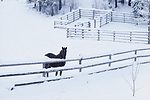Advertise Follow Us
Trimming
50 Best Farrier Takeaways Of 2015
Here’s a look back at a few of the top ideas that hoof-care professionals shared in the pages of American Farriers Journal during the past year
Read More
Give the Frog Proper Attention
Illinois farrier spends a lot of time examining and trimming the frog, and for good reason
Read More
Considerations For Successful Management Of Underrun Heels
Two veterinarians and a farrier survey considerations for addressing this foot condition
Read More
Preventing And Addressing Hoof Flares
Identifying and correctly managing deformations are critical to keeping horses sound
Read More








